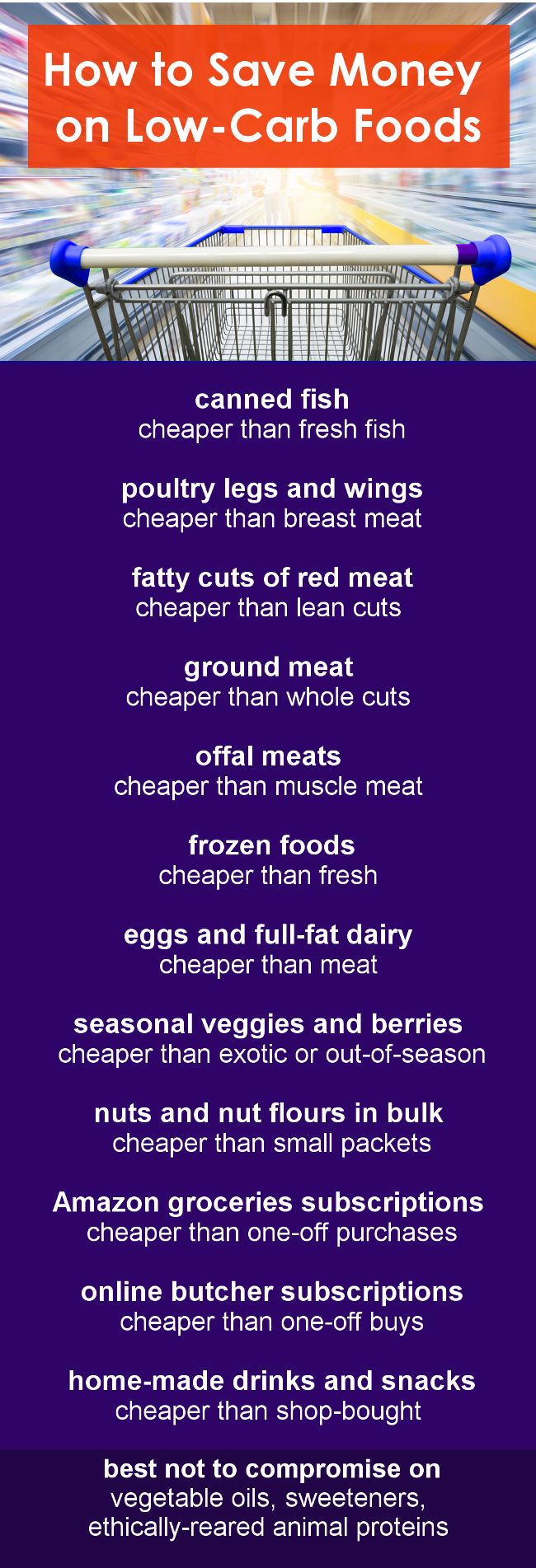
Are you worried about low-carb food prices? Does a low-carb diet mean spending a lot more money on groceries?
Staple low-carb foods like fresh meat, fish and vegetables can be expensive – but for a good reason. High-quality foods are more nutritious and healthy than cheap refined carbohydrates.
We are used to paying very little for white bread, pasta, potatoes and sugar. Their low prices reflect poor nutritional value.
We may understand the value of paying more for good food, but there are so many priorities to juggle. Few of us can afford to suddenly double or triple our groceries spend.
The good news is – we don’t have to. You can get affordable low-carb food. In fact, the most expensive stuff is not always the best.
Here are a few tips and tricks to help you save money on low-carb foods, without compromising on quality.
1. Canned or frozen fish instead of fresh
Canned or frozen fish is just as nutritious as fresh fish, but is a lot cheaper. And you don’t have to worry about it going off!
Canned fish usually has added sodium, because salt is a common natural preservative. Extra sodium is good on a low-carb diet – you need it to replenish your electrolyte levels.
Smaller fish bones become soft and edible when canned. So canned fish might have a bit more calcium, which is also good news.
Go for oily fish like salmon, mackerel and sardines. They are high in vitamins and healthy Omega-3 fatty acids. Versions in oil taste better than those canned with water or brine.
Add tinned fish to salads, stews and soups, or just have it on its own as a snack.
2. Poultry legs instead of breast meat
Chicken legs, thighs and drumsticks are cheaper than breast meat. White breast meat is leaner and is considered more premium (due to anti-fat brainwashing). Good news for us – on a low-carb diet, fatty meat is better than lean.
Fat also makes these cuts tastier. They come out great when fried, oven-baked or slow-cooked.
Recipe round-up: 50 Best Low-Carb Chicken Recipes by Low Carb Lab
3. Fatty cuts of red meat
As is the case with poultry, fatty cuts of meat are cheaper than leaner cuts – for the same reason.
Consider cuts like short ribs, shin of beef, lamb neck, lamb shanks, lamb shoulder and pork belly. Slower cooking methods tend to work better for fatty meats. Try braising, stewing, slow-cooking and roasting.
It’s easier to get these cuts from a butcher than from a supermarket. If there isn’t a butcher near you, go online. Many meat farms sell directly to consumers online, delivering nationwide.
One word of caution with red meat. You get much better-quality meat from free-range, grass-fed animals – plus it’s more ethical. Although more expensive, it is better value for money. This is one area where spending less may be a false economy.
American Grassfed Association – Members Directory
4. Ground meat instead of whole cuts
Ground meat (that’s minced meat if you are in the UK) is inexpensive because it comes from cheap cuts and fatty trimmings.
You can get ground versions of any red meat, or poultry like chicken or turkey. Ground turkey thigh meat is surprisingly tasty!
Once again, fatty ground meat is cheaper than lean – and better for your low-carb nutrition.
Ground meat is easy to cook. Just pan-fry it with some vegetables for a quick 10-minute meal, make meatballs or burgers or use it to stuff vegetables (bell peppers, courgettes, squash).
There are some great low-carb recipes with ground meat, like low-carb moussaka or low-carb lasagne.
Recipe round-up: 101 Low-Carb Ground Meat Recipes by I Breathe I Am Hungry
5. Offal meats
Most people think offal meats are a bit “ew”. That makes them very cheap.
If you can get over the squeamish factor, offal meats are fantastically nutritious, with more vitamins and nutrients than standard red meat.
Liver is the most common option, especially as pate. Please beware though – liver is not zero-carb. Glycogen is stored in the liver so it typically contains several grams of carbs per 100g. It’s too good to avoid though – so just be aware of those few extra carbs.
Other offal meats like kidneys, stomachs and even intestines are edible and can be delicious. Not for the faint-hearted, but worth it!
Oxtail, cheeks, tongue and marrow bones are not technically offal but are as shunned by the mass market. You can find these cuts from Paleo-minded butchers.
Cookbook: Odd Bits: How to Cook the Rest of the Animal
6. Frozen fish, seafood and vegetables
Frozen foods are cheaper, and can provide better quality than shop-bought fresh food.
Fresh products deteriorate rapidly while sitting on supermarket shelves. Frozen foods are frozen at the peak of their freshness, retaining the maximum goodness.
This is especially true for foods that perish quickly, like fish, seafood and vegetables.
7. Eggs and full-fat dairy
Eggs and full-fat dairy (cream, soured cream, hard and soft cheeses) are great sources of high-quality protein and healthy fats.
They have the perfect nutritional make-up for a low-carb diet and cost less than meat or fish.
Related post: How to jazz up scrambled eggs
8. Local, seasonal vegetables and berries
Buying locally-grown vegetables and berries in season will give you the best possible deal.
Not only these foods are cheaper when in the season, but they taste much better. Most veggies have a window of several months or even weeks when they are at their best. Take advantage of this timeframe.
Locally grown is a wide definition. At the very least, try to avoid foods that travel by plane from another country.
If you have a garden, seriously consider growing your own veggies, herbs and salads. Nothing beats freshly-picked vegetables!
Check local foods in season: Seasonal food guide
9. Nuts and nut flours in bulk
High-fat nuts are a great low-carb snack. Nut flours, like almond flour and coconut flour, are popular ingredients for low-carb baking.
Buying them in bulk – in packs of 5lbs or more – works out cheaper than buying small packets.
Nuts have a very long shelf life, so don’t worry about them expiring. They can keep for months and even years in a sealed container.
Buy low-carb nuts on Amazon
Buy almond flour in bulk on Amazon
10. Amazon groceries subscriptions
Amazon have a wide selection of groceries, including low-carb products. You can get up to 15% discount if you subscribe for regular monthly deliveries.
This is a win-win scenario – get the products that are hard to find in standard supermarkets delivered straight to your door, and pay less.
Here are some ideas for groceries to subscribe and save on Amazon:
11. Online butcher subscriptions
This may sound a bit mad, but you can buy a whole cow and have it delivered in bits over several months.
Several online butchers offer a subscription service. You commit to buying a huge amount of meat and get a substantial discount. Your meat is sourced and delivered fresh in reasonable-sized portions.
This is a great way to save money on high-quality grass-fed meat.
Meat subscription: Crowd Cow
12. Make hot drinks and snacks at home
Simple items like hot drinks, bottled water and snacks are expensive if you buy them from convenience stores or coffee shops.
Plan ahead – bring your own water or low-carb snacks from home.
Buying coffee from a coffee shop every day is an expensive habit. Change your ritual and get your own coffee machine – like Nespresso. It will pay for itself after one month or so.
What not to compromise on
Some foods are expensive for a good reason. Trying to pay less would be a false economy because of very poor quality.
Here are a few items where compromising on price is not worth it.
Vegetable oils
With vegetable oils, always go for high-quality options, preferably organic, cold-pressed vegetable oils. Coconut oil, olive oil, avocado oil and flaxseed oil are high in healthy fatty acids (Omega-3 and Omega-9) and beneficial omega oils.
Cheap, highly-refined oils are too high trans-fats and Omega-6 fatty acids. Most of us already get too much of Omega-6, which contributes to inflammation and other health issues. Cheap oils also contain chemical preservatives and pesticide residue.
Sweeteners
The cheapest sweeteners are aspartame and acesulfame-k. Many commercial sugar-free products are sweetened with these. Both are associated with potentially harmful side effects and can cause sugar cravings.
Cheap polyols like mannitol and sorbitol are also common. Unscrupulous manufacturers claim that all sugar alcohols are zero-carb which is not true. Most sugar alcohols (except for erythritol) are partially absorbed and converted to carbs.
The best sugar substitutes are Stevia, Monk fruit (luo han guo) and erythritol. They are zero-carb and completely safe to use on a low-carb diet.
Ethically-produced meat, chicken and eggs
Grass-fed, free-range and pasture-reared production methods are much better for animal welfare than intensive rearing.
But even if you don’t care about the ethical side, there is a simple reason to spend more on this type of food: it is better, both in terms of nutritional value and taste.
If you can afford to spend more on ethically produced animal proteins, you would get better value for your money overall.
Did we miss anything?
Do you have a tip for saving money on a low-carb diet?
Please share it in the comments.

Thanks for sharing such valuable information. Glad to read this blog.
Watch tinned fish in oil as it’s almost always in sunflower oil (at least in the UK). I have tinned mackerel in tomato sauce a lot for lunch, but again you have to watch out as many brands put sugar in it. There are a few who don’t and I prefer the Marks & Spencer brand (tried Sainsbury’s which also has no sugar, but it has less fish and more tomato sauce). With tuna, I buy in brine, then mix with olive oil and add some olives for lunch.
I’ve found I can buy good quality ingredients and not spend more than I used to because I’m not buying any of that high carb rubbish (eg, crisps and other snacks). The occasional fast reduces the food bill too.
Nice list! I really enjoy offal and lamb!
Thank you Mellie! Yes, I don’t really understand why offal isn’t more popular. More for us!
Considering you are a UK site why do all your links to Amazon go to the US site where there is no point in ordering.
Hi Wayne,
Actually all links are dynamic – the page is supposed to detect which location you are coming from, and give you links to Amazon.co.uk if your IP in in the UK, or Amazon.com for everyone else.
Although we are a UK website, almost 75% of our visitors are from the USA.
Anyway – it looks like our dynamic content system is not working very well! We have a plugin which relies on external IP databases to determine visitor’s location.
So thank you for alerting us – we will look into why it’s not working as expected.
I am not sure why your links are not working as expected (we will look into this), but here’s a list of UK-specific links that were supposed to come up for UK visitors.
Canned fish instead of fresh
Buy tinned fish on Amazon
Fatty cuts of red meat
UK grass-fed meat suppliers list
Offal meats
Cookbook: Odd Bits: How to Cook the Rest of the Animal
Local, seasonal vegetables and berries
Seasonal food guide
Nuts and nut flours in bulk
Buy low-carb nuts on Amazon
Buy almond flour in bulk on Amazon
Amazon groceries subscriptions
Meat subscription: Buy a whole cow
Coffee: Nespresso
Vegetable oils: organic, cold-pressed vegetable oils
Sweeteners: Stevia, Monk fruit (luo han guo) and erythritol.